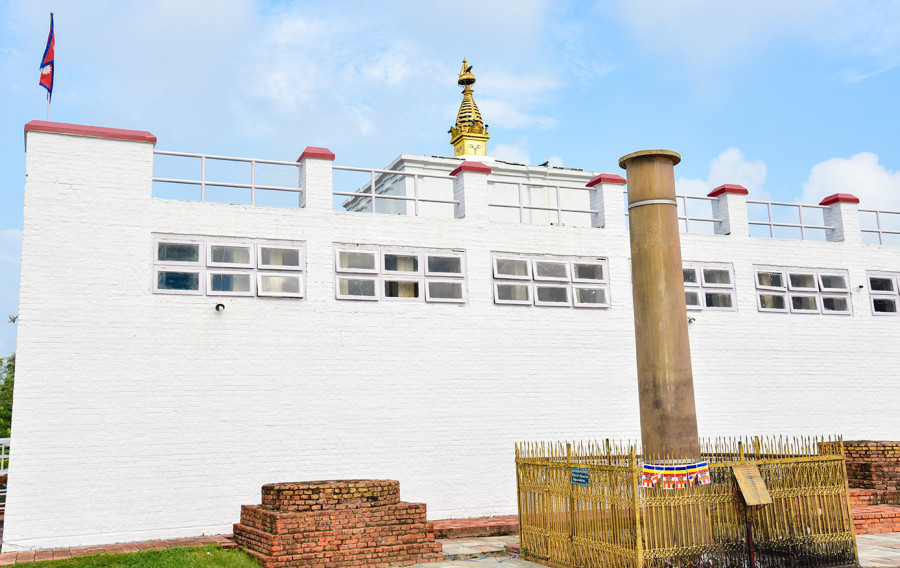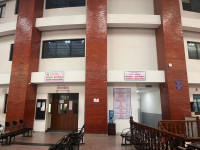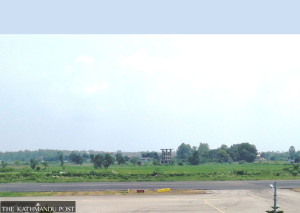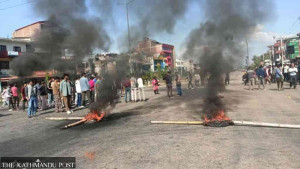National
Historic Ashoka Pillar in Buddha's birthplace is losing its shine amid negligence
Ashoka Pillar, a historically and archaeologically important artefact with an inscription mentioning the birth of Gautam Buddha, has been gradually deteriorating for the past few years. Archaeologists say that the increasing pollution level and direct contact with harmful particles in the air is weakening the pillar day by day.
Manoj Paudel
Ashoka Pillar, a historically and archaeologically important artefact with an inscription mentioning the birth of Gautam Buddha, has been gradually deteriorating for the past few years. Archaeologists say that the increasing pollution level and direct contact with harmful particles in the air is weakening the pillar day by day.
“A three-year-long study concluded two years back showed that there were some harmful particles on the stone pillar. With the rise in the pollution level, the state of the pillar is further deteriorating,” said senior archaeologist, Basanta Bidari.
UNESCO’s consultant and stone conservator, Constantino Meucci, and his team had carried out a detailed study of the pillar from 2013 to 2016 and submitted its study report. The study was conducted using infrared cameras and installing other modern equipment on the pillar. The study found that particles of cement, gypsum, crystal and small stones were found sticking to the pillar. Sulfur, smoke, dust and plastic pieces were also found on the outer layer of the pillar.
Archaeologists argue that the various chemicals will affect the stone in the long run. They underscore immediate measures to protect and preserve the historic pillar.
 The historic Ashoka Pillar in Lumbini is deteriorating due to the rising level of pollution. Post Photo: Manoj Poudel
The historic Ashoka Pillar in Lumbini is deteriorating due to the rising level of pollution. Post Photo: Manoj Poudel
The pillar erected by Indian emperor Ashoka in 249 BC is under open sky. It is surrounded by a metre-and-a-half high railing. Devotees place coins and other offerings at the foot of the pillar. Devotees from Thailand generally place incense sticks, Sri Lankans offer milk and people from the Tarai region of Nepal offer oil on the pillar in the form of their offerings to Lord Buddhha. Experts are of the opinion that such offerings discolour, disfigure and weaken the pillar over a long period of time. They claim that the pillar has already undergone some discolouration.
The pillar is 30 feet 10 inches high from the ground level. And 13 feet and 8 inches of the pillar is buried underground. Pushkarini Pond, where Maya Devi took her holy ablution after giving birth to Siddharth Gautam, is 15 metres south of the pillar. Meucci suspects that the water from the pond also might affect the stone pillar. In his report, the Italian professor recommends precautionary measures that can be taken to preserve the pillar. However, the Lumbini Development Trust (LDT) is yet to introduce any concrete steps for the preservation of the pillar. Project manager of LDT, Saroj Bhattarai, admitted to delays in implementing the study report to preserve the pillar. He however claimed that efforts are being made to preserve the pillar that confirms the birth of Buddha in Lumbini. “We will soon cover the pillar using some transparent materials. We could either use glass or fiber; we haven’t reached her decision yet,” said Bhattarai.
The local people blame the LDT for not taking proper initiatives to preserve and protect the historically important arts and artefacts of Lumbini. “The LDT has not taken any concrete steps to preserve this historical site. They can’t wait for these archaeological gems to completely deteriorate before they start their preservation process,” he said.
“Ashoka Pillar is proof to the fact that Buddha was born in Lumbini. That’s one of the reasons why immediate measures must be taken to preserve it,” said Maitri Mahasthabir, the chairman of Vikshu Mahasangha.




 12.12°C Kathmandu
12.12°C Kathmandu















